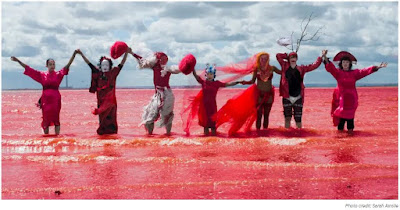 |
| Figure 1: Nüshu script (Source: CPA Mediat Pte Ltd/Alamy) |
For this closing post of March, of which all posts have been dedicated to Women (in appreciation of Women’s History Month), I want to discuss an aspect of China’s language and culture that you may not be aware of: Nüshu. This language is technically extinct (as it no longer has any native speakers) but is being revitalized through active participation by various Chinese women, under the sponsorship of the Chinese government. This post will address the history, purpose, and cultural significance of the Nüshu language.
Nüshu translates in Chinese to “women’s script”. It is just that-a written and possibly previously spoken language that was created and exclusively used by women in the Hunan province of China. It is believed to have started in the AD 900 and eventually peaked in use between 1644-1911 (during the Qing Dynasty). It was created by women for the purpose of discussing topics that they were forbidden to discuss openly, allowing them the freedom to express their thoughts without fear of repercussions. It was used largely among illiterate women, and it was taught and passed down from mother to daughter. It was also used among close knit groups of women who called themselves “sworn sisters”, a fictive kin network where three to four women swore allegiance to each other and provided support in both good and bad times.
Nüshu is a phonetic script that is read from right to left (a common characteristic of many Asian languages). It is written with sharp bamboo sticks, typically on paper for letters and journals and on fans, but it was also widely embroidered on clothing, belts, and handkerchiefs. The script is an elongated style with curved, thin strokes. The script is so fine in detail that it is often referred to as “mosquito writing,” a designation used to characterize the stylized script.
Women would use this script to communicate in secret amongst themselves, speaking about topics, such as domestic troubles or financial woes, that were considered taboo to discuss among others (or even within families). This script was therefore an outlet for women to express themselves freely in times when they were otherwise not allowed to. Women also used Nüshu to compose their own autobiographies or have their daughters compose them on their behalf. These writings, unfortunately, were often buried with the decedent and are not available to this day. There are, however, some early artifacts with Nüshu script present on them, which allows scholars the opportunity to study the length of time Nüshu was used.
Nüshu was unknown outside of the Hunan province until the mid-1900s. This was when Zhou Shuoyi learned about the language through an aunt who moved to a village where Nüshu was widely used. He began studying it, but his work was halted when the Cultural Revolution of China occurred in the 1960s. At that time the new leadership banned his studies, as well as destroyed his work. They also destroyed much of the early evidence of Nüshu due to its ties and representations of Imperial Chinese culture.
Despite these efforts, Nüshu remained in existence among a few women, allowing it to be rediscovered by Cathy Silber in 1986. She began studying the language, as well as brought world wide attention to it. Between her and Shuoyi’s efforts the language has begun to be revitalized. In the early 2000s the Chinese government sponsored and opened a series of museums and schools to teach Nüshu to interested individuals, who are largely women. This effort may very well have saved the language since the last native speaker passed away a few years later (as did Shuoyi). Today the language is being studied and passed on through a new generation of Nüshu users, and hopefully the revitalization movement will lead to a new renaissance of Nüshu use throughout China.
Works Cited
Endangered Alphabets Project. "Nushu." 2018. Atlas of Endangered Alphabets. Electronic. 15 December 2020.
Lofthouse, Andrew. "Nüshu: China's Secret Female-Only Language." 1 October 2020. BBC. Electronic. 15 December 2020.
Xiaorong, Chen. "Nüshu: from tears to sunshine." 2018. The UNESCO Courier. Electronic. 15 December 2020.

